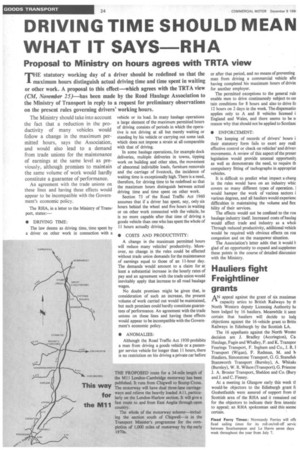DRIVING TIME SHOULD MEAN WHAT IT SAYS RHA
Page 26

If you've noticed an error in this article please click here to report it so we can fix it.
Proposal to Ministry on hours agrees with TRTA view
E statutory working day of a driver should be redefined so that the maximum hours distinguish actual driving time and time spent in waiting or other work. A proposal to this effect—which agrees with the TRTA view (CM, November 25)—has been made by the Road Haulage Association to the Ministry of Transport in reply to a request for preliminary observations on the present rules governing drivers' working hours.
The Ministry should take into account the fact that a reduction in the productivity of many vehicles would follow a change in the maximum permitted hours, says the Association, and would also lead to a demand from trade unions for the maintenance of earnings at the same level as previously, although promises to maintain the same volume of work would hardly constitute a guarantee of performance.
An agreement with the trade unions on these lines and having these effects would appear to be incompatible with the Government's economic policy.
The RHA, in a letter to the Ministry of Tranv port, states:— • DRIVING TIME: The law deems as driving time, time spent by a driver on other work in connection with a vehicle or its load. In many haulage operations a large element of the maximum permitted hours of driving consists of periods in which the operative is not driving at all but merely waiting or standing by his vehicle or carrying out some task which does not impose a strain at all comparable with that of driving.
In some haulage operations, for example dock deliveries, multiple deliveries in towns, tipping work on building and other sites, the movement of abnormal indivisible loads, furniture removals and the carriage of livestock, the incidence of waiting time is exceptionally high. There is a need, therefore, for driving time to be redefined so that the maximum hours distinguish between actual driving time and time spent on other work.
Section 73 of the Road Traffic Act 1960 assumes that if a driver has spent, say, only six hours behind the wheel and five hours in waiting or on other work connected with the vehicle, he is no more capable after that time of driving a goods vehicle than one who has spent the whole of 11 hours actually driving.
• COSTS AND PRODUCTIVITY: A change in the maximum permitted hours will reduce many vehicles' productivity_ Moreover, no change in the rules could be effected without trade union demands for the maintenance of earnings equal to those of an 11-hour day. The demands would amount to a claim for at least a substantial increase in the hourly rates of pay and an agreement with the trade union would inevitably apply that increase to all road haulage wages.
No doubt promises might be given that, in consideration of such an increase, the present volume of work carried out would be maintained, but such promises could hardly constitute guarantees of performance. An agreement with the trade unions on these lines and having these effects would appear to be incompatible with the Government's economic policy.
• ANOMALIES: Although the Road Traffic Act 1930 prohibits a man from driving a goods vehicle or a passenger service vehicle for longer than 11 hours, there is no restriction on his driving a private car before or after that period, and no means of preventing man from driving a commercial vehicle afte having completed his maximum hours of drivin for another employer.
The permitted exceptions to the general rule enable men to drive continuously subject to cei tam n conditions for 8 hours and also to drive fa 12 hours on 2 days in the week. The dispensatio applies only to A and B vehicles licensed i England and Wales, and there seems to be n, reason why that should not be applied to Scotian(
• ENFORCEMENT: The keeping of records of drivers' hours i their statutory form fails to exert any reall effective control or check on vehicles' and driven movements. A review of this aspect of the preser legislation would provide unusual opportunit) as well as demonstrate the need, to require th compulsory fitting of tachographs in appropriat vehicles.
It is difficult to predict what impact a chang in the rules would have on an industry whic covers so many different types of operation. 1 would hamper the work of various sectors i various degrees, and all hauliers would experienc difficulties in maintaining the volume and flex bility of their services.
The effects would not be confined to the roa haulage industry itself. Increased costs of haulag would affect trade and industry as a who'll Through reduced productivity, additional vehicls would be required with obvious effects on roa congestion and on the manpower situation.
The Association's letter adds that it would glad of an opportunity to expand and supplemet these points in the course of detailed discussior with the Ministry.












































































































